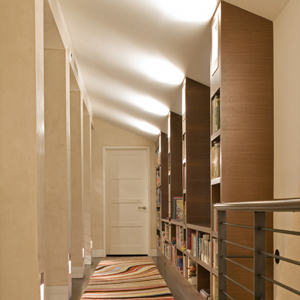Basic on/off schedules are just the tip of the iceberg when automating the lights.
One part of your house that shouldn’t be overlooked when you have a control system installed is the lighting.
Operated by a control system, the lights can turn on and off automatically based on the time of day and other parameters. Putting the lights on a schedule will certainly bring a new level of convenience to your daily schedule, and save money to boot, but there are many other setups that can be just as beneficial to your family.
Pathways: When you enter your home where’s the first place you typically go? The kitchen? The family room? Or maybe you head straight to the home office. The lights can illuminate a pathway to your destination. The lights can be triggered in a number of different ways: when you push a button on a keypad, when you disarm the security system, when you open the front door. The lights can be programmed to only turn on if it’s dark in the house and to automatically turn off after a certain length of time. Other popular pathways: from the bedroom to the bathroom, from the bedroom to the kitchen, from your bedroom to the kids’ bedrooms.
Fade to Black: This one’s ideal for media rooms and kids’ bedrooms. The lights from full on to completely off over a pre-determined period of time (3 minutes, 10 minutes, a half-hour—whichever you prefer). The gradual fade out lets people find their seats before the movie starts or helps lull kids to sleep.
Lived-in Look: Most control systems have a setting that can help make your home look occupied while your away by turning the lights on and off in a random pattern. Some can recall how you typically use the lights and can mimic your routine.
Daylight Harvesting: There’s no sense in using the lights when there’s ample sunshine to illuminate the space. Lights can work in concert with the help of a special sensor that measures the incoming natural light. If the sensor detects enough sunshine, it can trigger the control system which can then turn off the lamps and overhead fixtures.
Motion Triggered: How many times have you left the lights on in a closet or pantry? A motion sensor can preclude unnecessary energy use by turning off the lights when you leave the area. Conversely, it can switch on the lights when it notices you enter—ideal when you hands are busy with grocery bags and laundry baskets.
Astronomical Clock: If your control system has a built-in astronomical clock (most do), the certain lights can be programmed to turn on at dusk and off and dawn. It’s an ideal setup for exterior fixtures.
Ambiance: Groups of lights can be programmed to brighten and dim to certain intensity levels to help set the mood for a number of different activities and occasions. Each setting can be activated from a button on a handheld remote, a keypad or a touchpanel, making it a cinch to prepare your house for a party, dinnertime or a relaxing evening in front of the TV.
by Lisa Montgomery
http://www.electronichouse.com/article/7_ways_to_enhance_your_homes_lighting/
Custom Installation Services, LLC – Audio/Video Sales, Service and Installation in North Carolina and South Carolina




